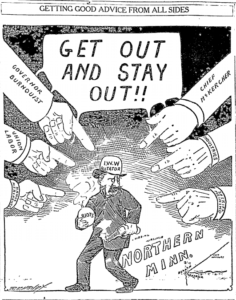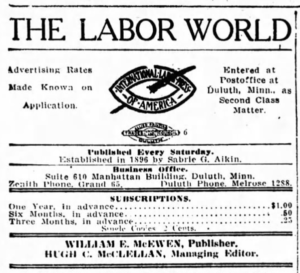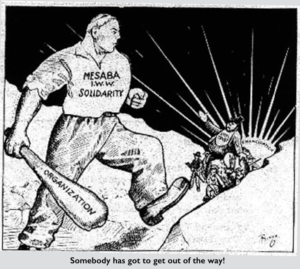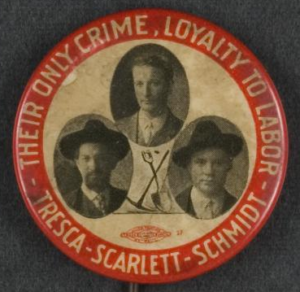There are no limits to which
powers of privilege will not go
to keep the workers in slavery.
-Mother Jones
~~~~~~~~~~~~~~~~~~~~~~~~~~~~~~~~~~~~~~~~~~~~~
Hellraisers Journal, Tuesday December 5, 1916
Minnesota Mesabi Iron Range – Bullets for Striking Miners?
The Duluth Labor World recently addressed the grave concern displayed by the Biwabik Times for the poor picked-upon Steel Trust. The Times believes that the Lumber Trust of Washington set a good example on the care and treatment of labor agitators when their deputized company gunthugs committed mass murder on Everett’s Bloody Sunday.
From The Labor World of December 2, 1916:
BIWABIK TIMES ADVOCATES MURDER!
The Biwabik Times in its issue of Nov. 24 openly
advocates murder!Think of it! That staunch defender of the poor unprotected steel trust!
It, advocates and even urges the citizens of Biwabik to take human life!
The Times is really worried over the plight of the poor unprotected steel trust. It isn’t fair to call another strike. So naturally the Times has its first convulsion when it learns that a strike of miners will be called on April 1, 1917.
Here is their recommendation:
“To the Times there is apparently but one way to stop this outrage, and that is to just as did the citizens of Everett, Washington.”
The Everett tragedy, contrary to the statements made by the Biwabik Times, is a sad commentary upon the characters and names of the Everett business men who promoted it.
Mayor Gill of Seattle in a public statement made it plain that he was not in sympathy with the I. W. W. movement.
Yet he said that “If the Everett authorities had an ounce of sense this tragedy would never have happened.
“In the final analysis,” continues Mayor Gill’s statement, “it will be found that these cowards of Everett, who without right or justification, shot into the crowd on the boat, were the real murderers and not the I. W. W.’s.
“The men who met the I. W. W.’s at the boat were a bunch of cowards.”
In the eyes of the law when Sheriff McRae and his Everett Chamber of Commerce gunmen, put their hands on their guns, they fired the first shot. They had no right to stop anyone from entering the city.
When the smoke cleared away the ground was dotted with dead, dying and wounded.
Citizens of Biwabik, if there is ever a tragedy of this kind in your city, look to the Times and place the responsibility.
The Times then goes on to say that once a strike is called in one or two mines and the men get interested, “the strike will spread all over the range.”
Which proves that there must be something rotten in the state of Denmark if a strike can be called so easily.
Why doesn’t the Biwabik Times get busy and secure decent, working conditions and wages for the miners and thus make a strike impossible?
———-
[Cartoon added.]
The Labor World also addressed the Chisholm Tribune-Herald:
SOMETHING WRONG.
The Chisholm Tribune-Herald thinks there is something wrong with The Labor World. It accuses us of “slipping to the level of solidarity and organized anarchy.”
Before we go any further, we wish to state that this is the first time we know that anarchy was “organized,” according to Webster and anarchists we have met.
St. Louis county needs The Labor World to help rid it of the steel trust’s anarchy.
We know lots of anarchists who shuddered at the steel trust’s anarchy during the Mesaba Range strike.
But perhaps we have “slipped.” Perhaps we have come closer to the hearts of the people.
We say perhaps. We don’t know. We are trying to do what is right and trying to come close to the hearts of the people.
Can’t you help us in your infinite wisdom. Tribune-Herald?
———-
Report to The Labor World by Harrison George:
PROSECUTOR DWELT ON NATIONALITY
OF PRISONERS
—–BY HARRISON GEORGE.
Special Investigator for The Labor World.
Besides the murder charges against eight strikers and organizers of the Iron Miner’s strike, there remains a number of lesser cases which are being heard at present. These were sifted out of the six hundred arrests made by deputized gunmen the Steel Trust imported to break the strike. The indictments are for alleged rioting, assault and kindred charges growing out of picketing. In themselves, these cases are not of great importance; yet they indicate the relentless attitude of the state when its forces are prostituted to the desires of organized capital.
In the case of Joe Blago, on trial for assaulting a deputy, Prosecutor Funk called for the state, a fourteen year old boy from whom, previous to trial, he had secured a statement—he writing the statement and having the boy sign it while under his influence and in his presence. Upon taking the stand the lad was admonished by the court as to the nature of an oath and as a consequence, absolutely corroborated the testimony of witnesses for the defense. Funk then brought out the statement and, failing in his endeavor to intimidate the lad with it—tried to have it admitted over the boy’s sworn testimony. He was prevented by the court upon objection. Funk then asked for conviction because Blago was a foreigner. The jury brought in a compromise verdict of simple assault instead of assault in second degree as charged.
Last week Eli Monovich, Rafael Pette and Steve Dronjak were tried for rioting. The state attempted to lay base for further prosecution for assault to kill as, on the day of the riot, Martin Teller, local chief of the Oliver gunmen, was stabbed slightly when attacking the picket line. Teller told the doctor who dressed his wounds that he did not see who cut him and didn’t know he was hurt till afterward; yet he had a story to tell the jury identifying Dronjak as the one who had stabbed him. All the trusty henchmen of the operators had the same general story. However, a few conflicting things they had overlooked caused the jury to discredit their yarns entirely, its verdict exonerating the prisoners from violence, inciting to violence or carrying weapons. Regardless of this, possibly because some juror, for reasons best known to himself, hung out for conviction, the jury judged Pette and Dronjak guilty of rioting. Defendants having been clubbed and having suffered some imprisonment, apparently the jury decided a little more of the same wouldn’t make much difference to them.
It was also shown that the deputies were so irresponsible that they clubbed one another during the excitement and that the fight was precipitated by a scab who had evidently arranged with the deputies to “start something” among the pickets.
One is reminded of the Industrial Relations Commission’s report, wherein is stated that,
In some localities the control by employers of the entire machinery of government is such that lawless acts on the part of the agents of employer go unpunished, while vindictive action against leaders of the strike is accomplished by methods unparalleled in civilized countries.
The U. S. Steel Corporation has announced a general raise of wages. Does anyone imagine this labor-hating crew has experienced a change of heart? Or does it fear that all workers in the steel industry may join with the miners now organized in the next fight with their exploiter? Does the Steel Trust wish to exculpate itself before working its murderous will upon Sam Scarlett, Joe Schmidt and Carlo Tresca?
———-
[Photographs added.]
SOURCE
The Labor World
(Duluth, Minnesota)
-Dec 2, 1916
http://chroniclingamerica.loc.gov/lccn/sn78000395/1916-12-02/ed-1/seq-4/
http://chroniclingamerica.loc.gov/lccn/sn78000395/1916-12-02/ed-1/seq-6/
IMAGES
MN Miners Strike, Get Out IWW, Cartoon, Duluth News Tribune, July 6, 1916
http://www.genealogybank.com
The Labor World, McEwen McClellan, Dec 2, 1916
https://www.newspapers.com/image/49876719/
Solidarity, Mesabi, Get Out of the Way, by R Chaplin (Bingo), Aug 19, 1916
http://www.iww.org/node/2556
MN Iron Range Strike, Tresca Scarlett Schmidt Button, 1916
http://quod.lib.umich.edu/l/lbc1ic/x-lbc.0321/LBC0321.TIF
Note: For date and title of cartoon by Chaplin/Bingo:
Rebel Voices: An IWW Anthology by Joyce L Kornbluh
PM Press, Mar 1, 2013
(Search: “August 19, 1916”)
https://books.google.com/books?id=sE0Qc0M61fkC
-For Ralph Chaplin as Bingo:
(+ many other sources…)
Wobblies!: A Graphic History of the Industrial Workers of the World
-by Paul Buhle, Nicole Schulman
Verso, 2005
(Search: bingo chaplin)
https://books.google.com/books?id=9ziQYFZgpBsC
See also:
Commission on Industrial Relations
https://en.wikipedia.org/wiki/Commission_on_Industrial_Relations
Final report of the Commission on Industrial Relations,
including the report of Basil M. Manly
and the individual reports and statements
of the several commissioners
WDC, Government Printing Office, 1916
https://books.google.com/books?id=NU2vAAAAIAAJ
Report of Basil M. Manly, Director of Research and Investigation
https://books.google.com/books/reader?id=NU2vAAAAIAAJ&printsec=frontcover&output=reader&source=gbs_atb&pg=GBS.PA17
The Manly Report List Four Causes of Industrial Unrest
https://books.google.com/books/reader?id=NU2vAAAAIAAJ&printsec=frontcover&output=reader&source=gbs_atb&pg=GBS.PA29
https://books.google.com/books/reader?id=NU2vAAAAIAAJ&printsec=frontcover&output=reader&source=gbs_atb&pg=GBS.PA30
The four are:
1. Unjust distribution of wealth and income.
2. Unemployment and denial of an opportunity to earn a living.
3. Denial of justice in the creation, in the adjudication, and in the administration of law.
4. Denial of the right and opportunity to form effective organizations.
The quote in George’s article above which begins: “In some localities the control by employers of the entire machinery of government is such that lawless acts on the part of the agents of employer go unpunished…” is found under cause #3-
Denial of Justice:
https://books.google.com/books/reader?id=NU2vAAAAIAAJ&printsec=frontcover&output=reader&source=gbs_atb&pg=GBS.PA38
The quote itself is at bottom of page 58:
https://books.google.com/books/reader?id=NU2vAAAAIAAJ&printsec=frontcover&output=reader&source=gbs_atb&pg=GBS.PA58




